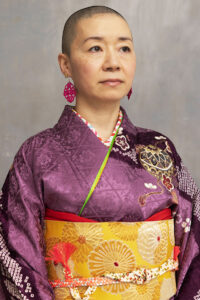‘Putting on a kimono is an art, I even studied for it’
Photography: Judith Anna Pronk
Trico Hallelujah (45) was born in Japan and is a single mother of Kosei (8), Ruka (6), Shuto (4) and Ryoga (2). There are more than a hundred kimonos in her wardrobe.
“In Japan, a kimono is much more than a beautiful piece of clothing. It is a way of expressing your identity, the phase of life you are in. For example, unmarried women wear a ‘furisode’, a kimono with long sleeves, and the black ‘tomesode’ is especially for mothers.
One hundred kimonos
As a child, I saw my parents wearing kimonos on festive occasions such as New Year’s Day. I loved the clothes and it made me proud to be Japanese. I now see that feeling in my own children. They have several kimonos and like to wear them. They also want to choose them themselves. “I want to wear this color today!” then they call.
I myself wore my first kimono when I turned twenty. In Japan you are officially an adult from that age and that is celebrated with the holiday Seijin no Hi. Especially for that occasion, my grandmother went shopping with me to buy me a furisode. I now own a hundred kimonos, but I cherish the Seijin no Hi, which I am wearing in this photo, the most.
Read also – Traveling to Japan with the camper: this family did it >
Craftsmanship
Most Japanese women only wear them on special occasions. I’m an exception in that regard, because I wear them almost every day. They are very comfortable, but also boost my self-esteem. I feel proud and complete in it. The kimonos also remind me of my mother and grandmother, some of whom I inherited.
“For exclusive, tailor-made kimonos you have to pay more than three thousand euros”
I bought most of my collection myself. Some in monthly installments, because for exclusive, custom-made kimonos you have to pay more than three thousand euros. Silk is precious and it is about pure craftsmanship.
Layers
Putting on a kimono is an art in itself: several layers must be carefully folded over each other. That requires knowledge and skill. I even studied for it and then worked as a kimono dresser and seller in Japan for twenty years.
Last year I moved to the Netherlands for my children’s education. In Japan, the Dutch education system is highly regarded. I also hope to pass on my knowledge about our traditional clothing to the Dutch and other Europeans. In my shop, where I sell kimonos for women, men and children, I teach people how to wear one. My dream is that the kimono will soon be just as appreciated as Japanese sushi.”

Receive Kek Mama with a discount and free shipping on your doormat every month! Subscribe now and pay only €4.19 per edition.
Post Views: 0



